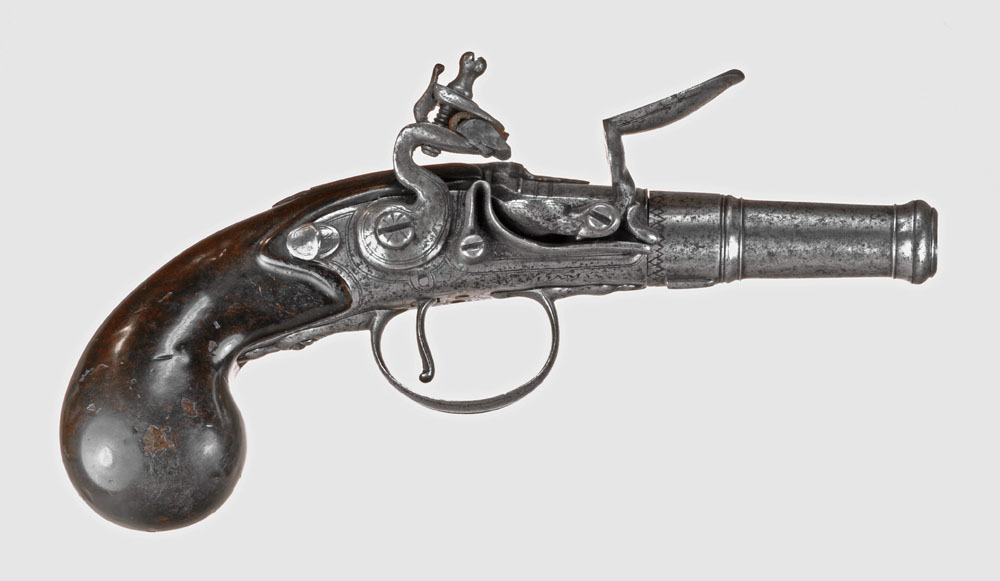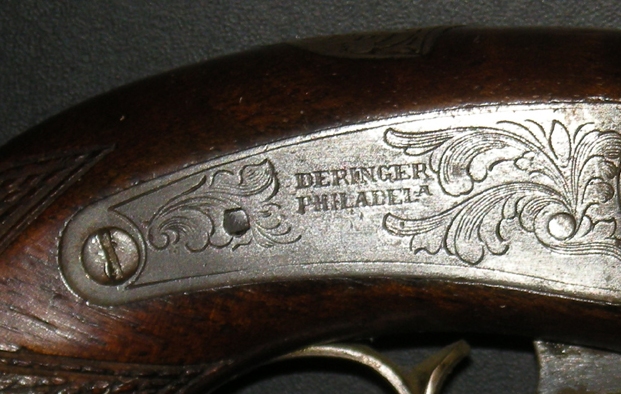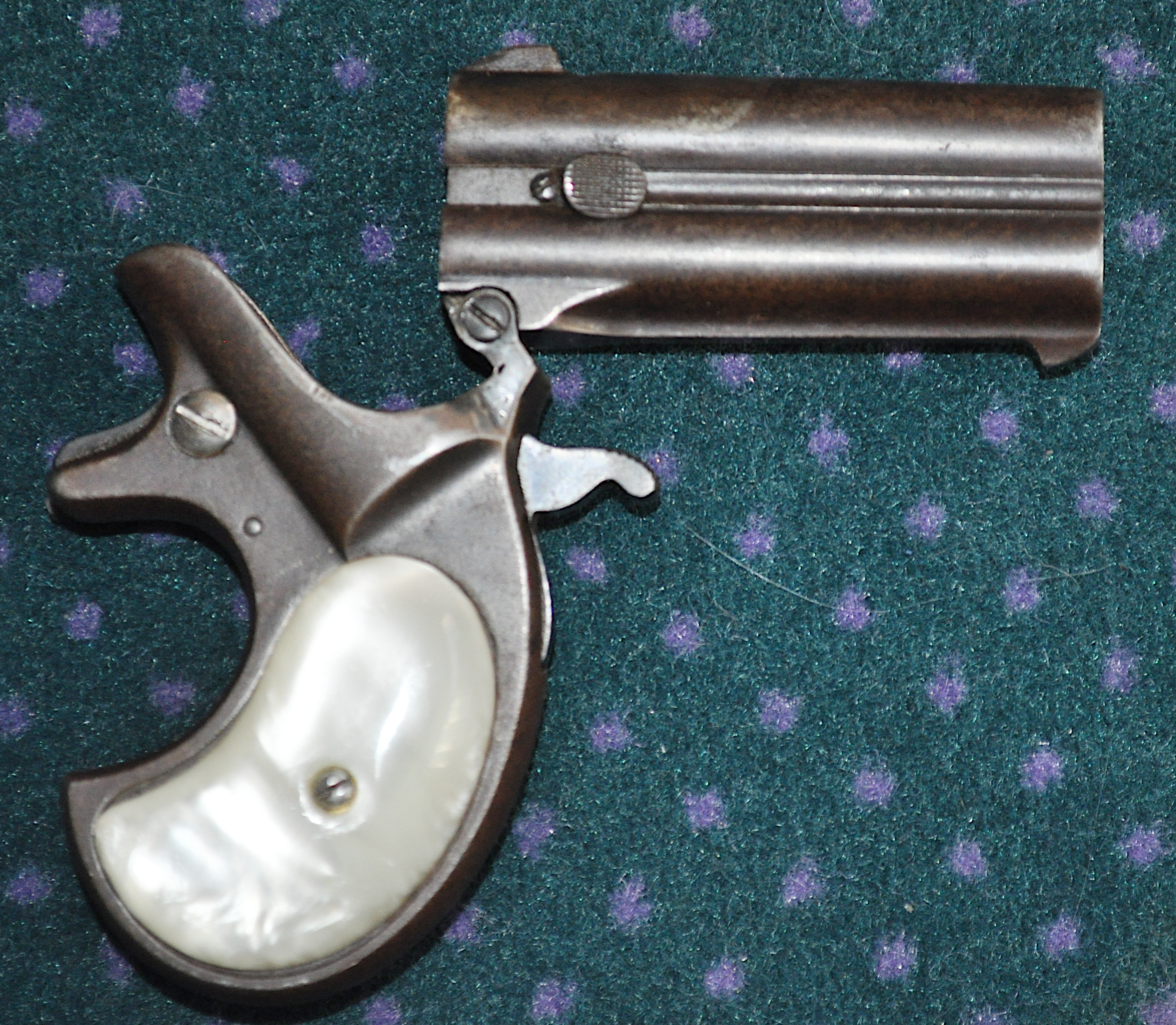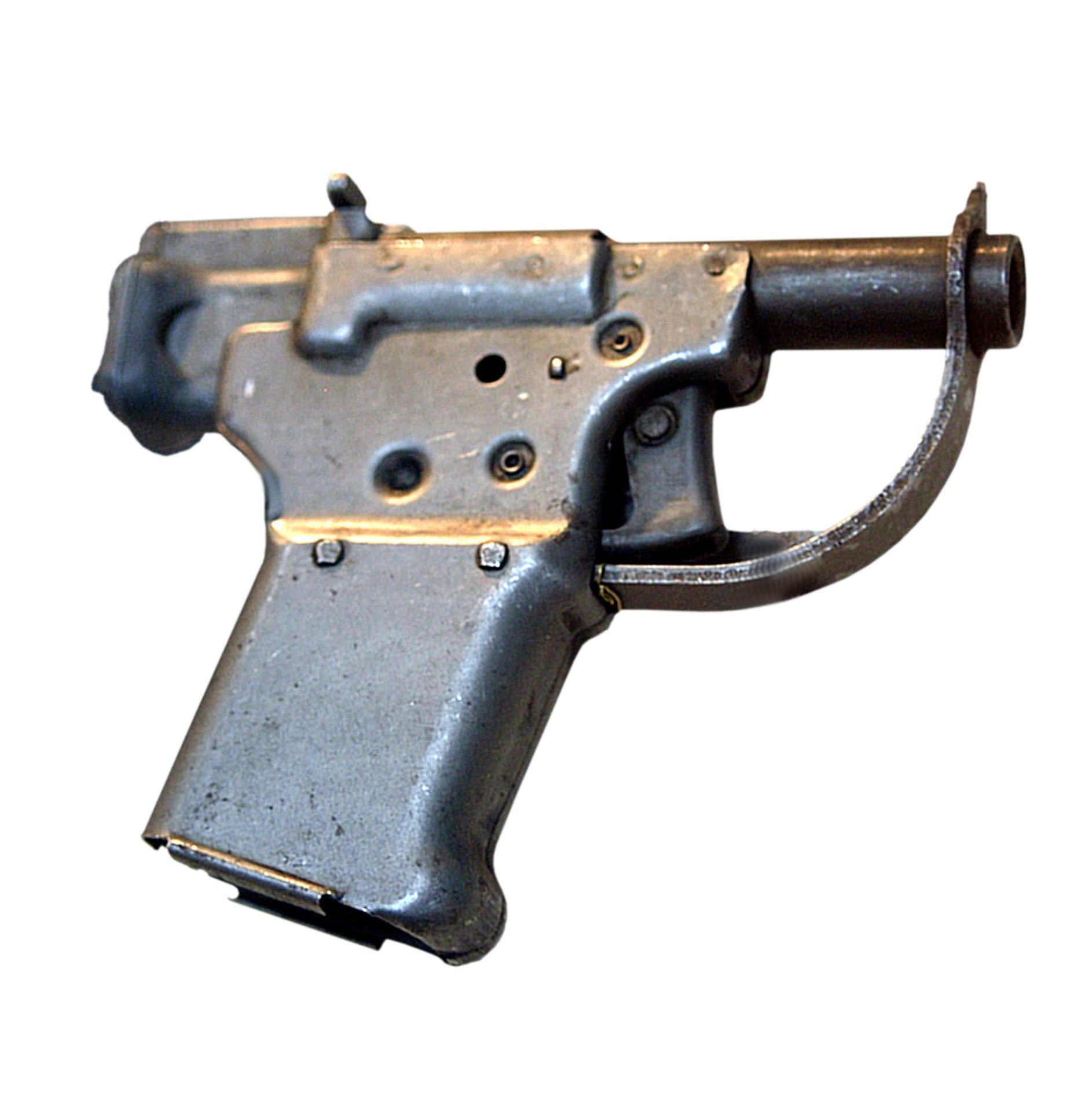Derringer Pistol on:
[Wikipedia]
[Google]
[Amazon]
 A derringer is a small
A derringer is a small
 The ancestor to the deringer of the Old West was the boxlock
The ancestor to the deringer of the Old West was the boxlock

 The Philadelphia Deringer was a small percussion
The Philadelphia Deringer was a small percussion
Colt Deringer.jpg, Colt Deringers, at right 1st Model (1870–1890), at left 3rd Model (1875–1912), all .41 rimfire
Colt 2nd Deringer.jpg, Colt 2nd Model Deringer
.41 Rimfire cartridge.JPG, .41 rimfire cartridge
 One of the more common deringers found in the Old West were the Sharps deringers. They are four-barrel, single-action pepperboxes with revolving firing pins. They come in
One of the more common deringers found in the Old West were the Sharps deringers. They are four-barrel, single-action pepperboxes with revolving firing pins. They come in


 A military pistol that is truly a deringer design is the FP-45 Liberator, a .45 ACP insurgency weapon dropped behind Axis lines in World War II. The FP-45 was a crude, single-shot pistol designed to be cheaply and quickly mass-produced. It had just 23 largely stamped and turned steel parts that were cheap and easy to manufacture. It fired a
A military pistol that is truly a deringer design is the FP-45 Liberator, a .45 ACP insurgency weapon dropped behind Axis lines in World War II. The FP-45 was a crude, single-shot pistol designed to be cheaply and quickly mass-produced. It had just 23 largely stamped and turned steel parts that were cheap and easy to manufacture. It fired a
Bond Arms Texas Defender Cowboy .45 .410.JPG, A modern .45 Colt and .410 bore Bond Arms derringer
COP 357.jpg, COP .357 Magnum derringer
Heizer-DoubleTap.jpg, DoubleTap .45 ACP derringer
The
The Booth Deringer – Genuine artifact or Replica?
a report of an FBI analysis of the Booth Deringer, made after rumors that the original had been stolen and replaced with a replica.
{{USCWWeapons Derringers American Civil War weapons Assassination of Abraham Lincoln Guns of the American West Multiple-barrel firearms Pistols
 A derringer is a small
A derringer is a small handgun
A handgun is a short- barrelled gun, typically a firearm, that is designed to be usable with only one hand. It is distinguished from a long gun (i.e. rifle, shotgun or machine gun, etc.), which needs to be held by both hands and also braced ...
that is neither a revolver
A revolver (also called a wheel gun) is a repeating handgun that has at least one barrel and uses a revolving cylinder containing multiple chambers (each holding a single cartridge) for firing. Because most revolver models hold up to six roun ...
nor a semi/ fully automatic pistol. It is not to be confused with mini-revolvers or pocket pistols, although some later derringers were manufactured with the pepperbox configuration. The modern derringer is often multi-barreled, and is generally the smallest usable handgun of any given caliber
In guns, particularly firearms, caliber (or calibre; sometimes abbreviated as "cal") is the specified nominal internal diameter of the gun barrel Gauge (firearms) , bore – regardless of how or where the bore is measured and whether the f ...
and barrel
A barrel or cask is a hollow cylindrical container with a bulging center, longer than it is wide. They are traditionally made of wooden staves and bound by wooden or metal hoops. The word vat is often used for large containers for liquids, ...
length due to the lack of a moving action, which takes up more space behind the barrel. It is frequently used by women because it is easily concealable in a purse or a stocking.
The original Philadelphia Deringer was a muzzleloading caplock single-shot pistol
A pistol is a handgun, more specifically one with the chamber integral to its gun barrel, though in common usage the two terms are often used interchangeably. The English word was introduced in , when early handguns were produced in Europe, an ...
introduced in 1825 by Henry Deringer. In total, approximately 15,000 Deringer pistols were manufactured. All were single barrel pistols with back-action percussion locks, typically .41 caliber with rifled
In firearms, rifling is machining helical grooves into the internal (bore) surface of a gun's barrel for the purpose of exerting torque and thus imparting a spin to a projectile around its longitudinal axis during shooting to stabilize the proj ...
bores, and walnut stock
In finance, stock (also capital stock) consists of all the shares by which ownership of a corporation or company is divided.Longman Business English Dictionary: "stock - ''especially AmE'' one of the shares into which ownership of a company ...
s. Barrel length varied from , and the hardware was commonly a copper-nickel alloy known as " German silver".
The term "derringer" () became a genericized misspelling during the reporting of the Lincoln assassination, which was committed with a concealed Philadelphia Deringer. Many copies of the original Philadelphia Deringer pistol were made by other gunmakers worldwide, and the name remained often misspelled; this misspelling soon became an alternative generic term for any pocket pistol, along with the generic phrase "palm pistol'", which Deringer's competitors invented and used in their advertising. With the advent of metallic cartridges, pistols produced in the modern form are still commonly called "derringers".
Precursors
 The ancestor to the deringer of the Old West was the boxlock
The ancestor to the deringer of the Old West was the boxlock overcoat pistol
Queen Anne pistols are a type of breech-loading flintlock pistol known as a turn-off pistol, in which the chamber (firearms), chamber is filled from the front and accessed by unscrewing the barrel (firearms), barrel. Another distinguishing featur ...
used by travellers from the late 18th century onwards as protection from highwaymen. These were also known as boot pistol
Queen Anne pistols are a type of breech-loading flintlock pistol known as a turn-off pistol, in which the chamber (firearms), chamber is filled from the front and accessed by unscrewing the barrel (firearms), barrel. Another distinguishing featur ...
s, Toby pistols, manstopper pistol
Stopping power is the ability of a weapon – typically a ranged weapon such as a firearm – to cause a target (human or animal) to be incapacitated or immobilized. Stopping power contrasts with lethality in that it pertains only to a weapon's ...
s, vest pocket pistols, and muff pistols because they could be concealed in a woman’s hand-warmer muff. Originally made as flintlocks, later versions used cap and ball ignition and sometimes featured turn-off barrels for faster reloading. Double-barreled caplock pocket pistols, commonly known as twister pistols, became popular in England during the Regency era and also saw use among Union Army officers during the American Civil War. These served as the forerunner to the Old West gambler's over-and-under deringer, and also to the pepperbox revolver with the addition of a ratchet to mechanically rotate the barrels.
Philadelphia Deringer


handgun
A handgun is a short- barrelled gun, typically a firearm, that is designed to be usable with only one hand. It is distinguished from a long gun (i.e. rifle, shotgun or machine gun, etc.), which needs to be held by both hands and also braced ...
designed by Henry Deringer (1786–1868) and produced from 1852 through 1868. A popular concealed carry handgun of the era, this pocket pistol design was widely copied by competitors, sometimes down to the markings.
For loading a Philadelphia Deringer, one would typically fire a couple of percussion caps on the handgun, to dry out any residual moisture contained in the tube or at the base of the barrel, to prevent a subsequent misfire. One would then remove the remains of the last fired percussion cap and place the handgun on its half-cock notch, pour of black powder down the barrel, followed by ramming a patched lead ball down onto the powder, being very careful to leave no air gap between the patched ball and the powder, to prevent the handgun from exploding when used. (The purpose of the patch on the ball was to keep the ball firmly lodged against the powder, to avoid creating what was called a "short start" when the ball was dislodged from being firmly against the powder.)
A new percussion cap would then be placed on the tube (nipple), and the gun was then loaded and ready to fire. (The half-cock notch prevented the hammer from falling if the trigger was bumped accidentally.) Then, to fire the handgun, the user would fully cock the hammer, aim, and squeeze the trigger. Upon a misfire, the user could fully re-cock the hammer, and attempt to fire the handgun once more, or, switch to a second Deringer. Accuracy was highly variable; although front sights were common, rear sights were less common, and some Philadelphia Deringers had no sights at all, being intended for point-and-shoot use instead of aim and shoot, across poker-table distances. Professional gamblers, and others who carried regularly, often would fire and reload daily, to decrease the chance of a misfire.
Deringer's production records, and contemporaneous records of his imitators, indicate that these pistols were almost always sold in matching pairs. (A typical price was $15 to $25 for a pair, with silver-inlaid and engraved models selling at higher prices.) The choice of buying a pair, in part, was to compensate for the limited power of a single-shot, short-barreled pistol, and to compensate for a design considerably less reliable than subsequent cartridge derringer designs. Original Deringers are almost never found still in their matched pairs today.
Initially popular with military officers, the Deringer became widely popular among civilians who wished to own a small and easily concealable pistol for self-defense. In the Old West, derringers were commonly known as vest-pocket pistols, sleeve guns, and boot pistols.
In total, approximately 15,000 Deringer pistols were manufactured. All were single-barrel pistols with back action percussion locks, typically 0.41" rifled bores, and walnut stocks. Barrel length varied from 1.5" to 6", and the hardware was commonly a copper-nickel alloy known as " German silver". The back action lock was a later, improved design among locks, which had its spring and mechanism located behind the hammer, where it was thereby protected from dirt, fired cap residue, and gunpowder residue, unlike earlier front action locks that had their springs and mechanism located directly in the path of such residue in front of the hammer, under the tube.
Because of their small size and easy availability, Deringers sometimes had the dubious reputation of being a favored tool of assassins. The most famous Deringer used for this purpose was fired by John Wilkes Booth who assassinated
Assassination is the murder of a prominent or important person, such as a head of state, head of government, politician, world leader, member of a royal family or CEO. The murder of a celebrity, activist, or artist, though they may not have a ...
United States President Abraham Lincoln at Ford's Theatre in Washington, D.C., on April 14, 1865. Booth's Deringer was unusual in that the rifling twisted counterclockwise (left-handed twist), rather than the typical clockwise twist.
Colt Deringer
Daniel Moore patented a single-shot metallic cartridge.38 Rimfire
.38 rimfire cartridges are a type of ammunition that have been in service in the United States since the mid-nineteenth century. The cartridges are produced in short, long and extra long variants.
Much like the smaller .32 rimfire, the roun ...
pistol in 1861. These pistols had barrels that pivoted sideways on the frame to allow access to the breech for reloading. Moore would manufacture them until 1865 when he sold out to the National Arms Company, which produced single-shot .41 Rimfire Deringers until 1870 when it was acquired by Colt's Patent Firearms Manufacturing Company. Colt continued to produce the .41 Rimfire Deringer after the acquisition, as an effort to help break into the metallic-cartridge gun market, but also introduced its own three single-shot Colt Deringer models, all of them also chambered in the .41 Rimfire cartridge. The last model to be in production, the third Colt Deringer, was not dropped until 1912. The third Colt Deringer model was re-released in the 1950s for western movies, under the name "Fourth Model Colt Deringer".
Sharps Deringer
 One of the more common deringers found in the Old West were the Sharps deringers. They are four-barrel, single-action pepperboxes with revolving firing pins. They come in
One of the more common deringers found in the Old West were the Sharps deringers. They are four-barrel, single-action pepperboxes with revolving firing pins. They come in .22 .22 caliber, or 5.6 mm caliber, refers to a common firearms bore diameter of 0.22 inch (5.6 mm).
Cartridges in this caliber include the very widely used .22 Long Rifle and .223 Remington / 5.56×45mm NATO.
.22 inch is also a popular ...
, .30 and .32 rimfire
The term .32 rimfire refers to a family of cartridges which were chambered in revolvers and rifles in the late 19th and early 20th centuries. These rounds were made primarily in short and long lengths, but extra short, long rifle and extra long ...
, and their four barrels slide forward to load and unload. First patented in 1849, they were not made until 1859, when Sharps patented a practical derringer design. These first model deringers have brass frames and fired the recently introduced .22 Rimfire metallic cartridges. The second model was a .30 Rimfire deringer. The third model deringer was a .32 Rimfire, with an iron frame, and the barrel release was moved from under the frame to the left side of the frame. The fourth model deringer was also a .32 Rimfire, with a new "birdshead" grip and slightly shorter barrels, otherwise, it was virtually identical to the third model. Production of these little pistols came to an end with the death of Christian Sharps in 1874.
Remington Deringers


Remington Arms
Remington Arms Company, LLC was an American manufacturer of firearms and ammunition, now broken into two companies, each bearing the Remington name. The firearms manufacturer is ''Remington Arms''. The ammunition business is called ''Remingto ...
manufactured more than 150,000 Model 95 over-under double-barreled derringers, also called the ''Model 95 Double Deringer'', from 1866 until the end of their production in 1935. The gun was made only in .41 rimfire. The Remington derringer design doubled the capacity while maintaining a compact size, by adding a second barrel on top of the first and pivoting the barrels upward to reload. Each barrel chambered one round, and a cam on the hammer alternated between the top and bottom barrels. There were four models with several variations. The .41 Short bullet moved very slowly, at about , around half the speed of a modern .45 ACP
The .45 ACP ( Automatic Colt Pistol) or .45 Auto (11.43×23mm) is a rimless straight-walled handgun cartridge designed by John Moses Browning in 1904, for use in his prototype Colt semi-automatic pistol. After successful military trials, it ...
but later testing with modern chronographs has revealed that original ammunition gave velocities between 6-700 F/S. This is significantly faster than originally thought back in the '60 when early chronographs were used to make the prior tests.
Remington also constructed the .32 short Rimfire "Rider Magazine Repeating" pistol. The magazine tube under the barrel held five rounds of ammunition, plus one in the chamber. Muzzle velocity was between 675 and 700 F/S with a 60-grain .32 bullet. This particular model featured a hammer that also drew back the breach block and lifted a new cartridge out of the magazine upon cocking. Relaxing one’s grip on the hammer closed the breech block, but left the hammer cocked.
FP-45 Liberator
 A military pistol that is truly a deringer design is the FP-45 Liberator, a .45 ACP insurgency weapon dropped behind Axis lines in World War II. The FP-45 was a crude, single-shot pistol designed to be cheaply and quickly mass-produced. It had just 23 largely stamped and turned steel parts that were cheap and easy to manufacture. It fired a
A military pistol that is truly a deringer design is the FP-45 Liberator, a .45 ACP insurgency weapon dropped behind Axis lines in World War II. The FP-45 was a crude, single-shot pistol designed to be cheaply and quickly mass-produced. It had just 23 largely stamped and turned steel parts that were cheap and easy to manufacture. It fired a .45 caliber
This is a list of firearm cartridges which have bullets in the to caliber range.
*''Length'' refers to the cartridge case
Case or CASE may refer to:
Containers
* Case (goods)
A case of some merchandise
Merchandising is any practic ...
pistol cartridge from an unrifled barrel. Due to this limitation, it was intended for short-range use () either as a last-ditch self-defense gun or to sneak up on and kill an unsuspecting Axis soldier to steal a more serviceable weapon. Its maximum effective range was only about . At longer range, the bullet would begin to tumble and stray off course. Five extra rounds of ammunition could be stored in the pistol grip. The original delivered cost for the FP-45 was $2.10 per unit, lending it the nickname " Woolworth pistol".
Modern designs
While the classic Remington design is asingle-action
A trigger is a mechanism that actuates the function of a ranged weapon such as a firearm, airgun, crossbow, or speargun. The word may also be used to describe a switch that initiates the operation of other non-shooting devices such as a trap, a ...
deringer with a hammer and tip-up action, the High Standard D-100, introduced in 1962, is a hammer-less, double-action derringer with a half-trigger-guard and a standard break action design. These double-barrel derringers were chambered for .22 Long Rifle and .22 Magnum
The .22 Winchester Magnum Rimfire, also called .22 WMR, .22 Magnum, .22 WMRF, .22 MRF, or .22 Mag, is a rimfire cartridge. Originally loaded with a bullet weight of delivering velocities in the range from a rifle barrel, .22 WMR is now loaded ...
and were available in blued, nickel, silver, and gold-plated finishes. Although they were discontinued in 1984, American Derringer obtained the rights to the High Standard design in 1990 and produced a larger, .38 Special
The .38 Special, also commonly known as .38 S&W Special (not to be confused with .38 S&W), .38 Smith & Wesson Special, .38 Spl, .38 Spc, (pronounced "thirty-eight special"), or 9x29mmR is a rimmed, centerfire cartridge designed by Smith & ...
, version. These derringers, called the "DS22" and "DA38", are still made and are popular concealed-carry handguns.
COP 357
The COP .357 is a 4-shot Derringer-type pistol chambered for .357 Magnum. The double-action weapon is about twice as wide, and substantially heavier than the typical .25 automatic pistol, though its relatively compact size and powerful cartridge ...
is a four-barrel, hammerless, double-action, .357 Magnum
The .357 Smith & Wesson Magnum, .357 S&W Magnum, .357 Magnum, or 9×33mmR as it is known in unofficial metric designation, is a smokeless powder cartridge with a bullet diameter. It was created by Elmer Keith, Phillip B. Sharpe, and Douglas B. ...
derringer with the barrels stacked in a 2 × 2 block. Introduced in 1984, it is not much larger than a .25 ACP
The .25 ACP ( Automatic Colt Pistol) (6.35×16mmSR) is a semi-rimmed, straight-walled centerfire pistol cartridge introduced by John Browning
John Moses Browning (January 23, 1855 – November 26, 1926) was an American firearm designe ...
semi-automatic pistol, and is significantly smaller than a small-frame revolver. A smaller-caliber version of the "Mini COP" in .22 Magnum was also made by American Derringer.
DoubleTap derringers are modern, hammerless, double-action, double-barreled, large caliber derringers designed for personal protection and introduced by DoubleTap Defense in 2012. They feature stainless steel ported barrels and aluminum or titanium alloy frames. They also hold two extra rounds in the grip. Its makers have stated that they drew inspiration from the FP-45 Liberator pistol, which also held extra ammo in the grip.
See also
*Cobray
The Cobray Company was an American developer and manufacturer of submachine guns, automatic carbines, handguns, shotguns, and non-lethal 37 mm launchers. These were manufactured by SWD. In the 1970s and 1980s, Cobray was a counter terrorist trai ...
* Deer gun
The Deer gun, developed by the CIA, was a successor to the FP-45 Liberator, Liberator pistol. The single-shot Deer gun was intended for distribution to South Vietnamese guerrillas as a weapon against North Vietnamese soldiers.
Design
The Deer gu ...
* Garrucha
Garrucha is a municipality of Almería province, in the autonomous community of Andalusia, Spain. Garrucha is a seaport of south-eastern Spain on the Mediterranean Sea and the right bank of the river Antas. In 1998 the town had a population of 500 ...
* Mini-revolvers
* Protector Palm Pistol
References
External links
The Booth Deringer – Genuine artifact or Replica?
a report of an FBI analysis of the Booth Deringer, made after rumors that the original had been stolen and replaced with a replica.
{{USCWWeapons Derringers American Civil War weapons Assassination of Abraham Lincoln Guns of the American West Multiple-barrel firearms Pistols